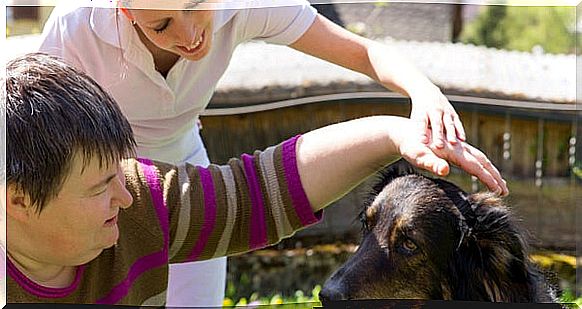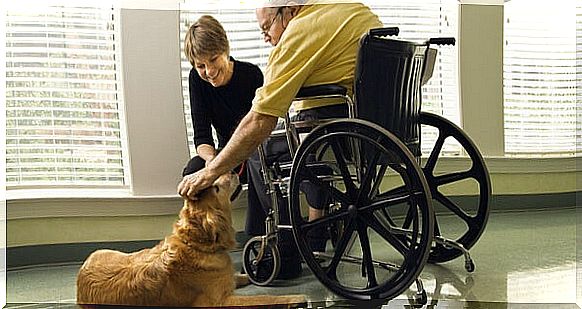Dog Therapy: What Are Its Benefits?

The dog is the quintessential companion animal. There must be a reason! No matter what day you had or how bad your workday was, they are always there. But apart from this loyalty, dog therapy is another of the great help that these animals give us.
This type of therapy is used to assist people with disabilities, Alzheimer’s, depression and even autistic children. They have multiple physical, psychological and social benefits. Get to know them!
Who is dog therapy indicated for?
Dogs are the animals most used in animal-assisted therapy. They are proven to help improve the health and well-being of patients. This type of therapy is based on assistance and the performance of interventions in which the interaction between the animal and the person is introduced as a key point.
It is important to understand it as a complement to clinical therapies, not as a substitute or alternative to other conventional treatments. They also have to be supervised and directed by health or educational professionals. An interdisciplinary work is needed to be able to obtain the expected results.
This type of assistance has been used successfully to treat people with a multitude of problems. Among them, emotional and behavioral disorders, such as ADHD, stress, anxiety or depression. Addictions or psychic and neurological disorders, such as Alzheimer’s. And also for autism spectrum disorders, venereal diseases such as AIDS or with dependent and elderly people.

Two types of therapy dogs
The dogs used in these therapies must meet a series of criteria or specific characteristics. It is convenient that they be agile, active, with temperament, obedient, loving, patient and kind. Once this initial filter is passed, they must be able to be trained as therapy dogs.
Two types of dogs must be differentiated, depending on the goal of therapy:
- Assistance dogs: they are trained to help people with specific needs. For example, guide dogs for the blind, those that assist deaf people or those that become a support for people with physical disabilities.
- Therapy dogs: are those who become helpers or “co-therapists.” They are used to achieve greater interaction with patients. His work focuses on the elderly, autistic children or individuals with other types of psychological disorders.
Its multiple psychological and emotional benefits
In people with acquired brain damage it is very useful to do therapy with dogs, because they increase their motivation. As a method to speed up their rehabilitation, interacting with these animals serves as an incentive and as a way to stay active. Feeding them or doing activities with them stimulates them mentally. In turn, this improves their attention and strives to keep up.
It also prevents them from feeling lonely. Dogs are considered man’s best friends, because they accept us unconditionally. Just as we are. That is why they are a kind of natural therapists, who serve us as an antidote to fight against anxiety, depression, stress or monotony.
Patients find your company very pleasant, especially if they are animal lovers. Normally, they prefer to go recovering with another living being and not using a totally mechanical exercise machine.
In addition, the bond that is created between the dog and the person goes beyond mutual affection. Many consider it to be similar to the bond that the mother creates with her baby. As a consequence of all these benefits, dog therapy improves the mood of patients.
Physical and social benefits
Dog therapy increases the physical activity of patients. Playing with them, doing activities of bending, twisting or walking allows to strengthen the muscles, bones and joints. Likewise, it facilitates a better development of the vestibular system, increases proprioception and muscular strength.
On the other hand, it improves motor skills, both gross and fine, and coordination because it works all the patient’s senses, from sight to hearing or touch. Also thanks to activities such as stroking, feeding, caring for or brushing their hair, a greater command of specific movements is obtained, especially of the hands and arms.
Therefore, in addition to being a powerful communication bridge between the therapist and the patient, dog therapy produces learning through play. It encourages social contact and the development of leisure skills. And it improves multiple skills such as empathy, respect, communication, cooperation and teamwork.

Its great advantage: versatility
Therapy with dogs can be done both in groups and individually. It depends on the needs of each patient and the most appropriate way of approaching the disability, disorder or difficulty of the person. Likewise, compared to other therapies that only allow it to be carried out in a specialized center, these can also be done at home. Personalized attention can be aimed at people of any age, from children to the elderly.
In addition to being one of the pets preferred by children and adults, dogs offer us real possibilities for healing. Using them as a complement to a therapy offers, as we see, multiple benefits at all levels. This means that more and more are incorporated to the help and assistance of problems with alterations and disabilities.









